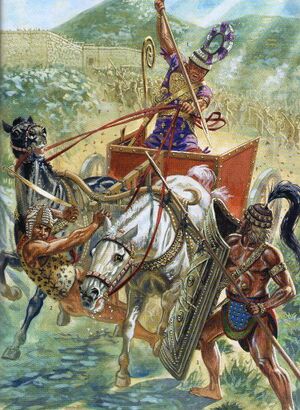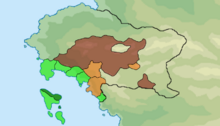Totonac Wars
| Totonac Wars | |||||||
|---|---|---|---|---|---|---|---|
| Part of the Tepanec-Thai wars | |||||||
 Tepanec war chariot against Totonac infantry | |||||||
| |||||||
| Belligerents | |||||||
| |||||||
| Commanders and leaders | |||||||
The Totonac Wars are a serie of conflicts that opposed the Azcapotzalco Tlatholoyan and the Grand Empire of Thae Kaew during the late 15th century. Totonacapan was an economically advanced region, serving as a trading hub between Irathava and Nepantia. It was divided into three states, Papantlan, Tuxpan, and Cempoala, with Papantlan enjoying the greater prestige out of them for its size, population, and position as the successor of the old Tajin. It's the conquest of Papantlan by Azcapotzalco that would trigger the following conflicts, as the Tlatholoyan was now threatening the coastal states, some of which were vassals or allies of the Thae Kaew.
Prelude
Since its rulers have claimed the title of Huetlatoani ("Great Speaker" or "Emperor") 60 years prior, the city of Azcapotzalco expanded greatly outside of its home valley. It's latest successful campaign, triggered by a plea for help from its allied city of Teotlan, was led by the Huetlatoani Chimalopoca against the kingdom of Xelaju, ended with a crushing victory and the installation of a permanent Nahua settlement to keep the defeated kingdom in check.
Chimalopoca's son, Tezozomoc II, continued his father and great-grandfather's expansionists policies. Using the murder of Azcapotli merchants and the staunch refusal of Papantlan to allow Azcapotli troops in its territories to secure trades, Tezozomoc launched a successful invasion of Papantlan in 1490. Papantlan's king found refuge in the neighboring state of Tuxpan, another Totonac state.
All three Totonac states then formed a defensive alliance against Azcapotzalco, as they feared Tezozomoc II would seek any excuse to invade all of their lands and gain an access to the ocean. The same year, this League of the Three Hearts sent emissaries to the Thae Kaew, their main economic partner and until-then nominal hegemon. The Thae Kaew answered positively to the Totonacs' demands and reinforced their trade ports in Nepantia. Undeterred by this sudden display of force, Tezozomoc II nonetheless started a new campaign against Tuxpan for harboring the exiled king of Papantlan.
Wars
First Totonac War or War of Tuxpan
Because they continued to protect and support the exiled king of Papantlan and his network of resistants to the Tepanec occupation, Tezozomoc II sent one of his general at the head of an army of 25,000 men to invade Tuxpan.
At first unopposed, the Tepanecs met in battle with the allied forces of the Totonacs cities and the Thae, and were defeated. Retreating to their main camp, the Tepanecs sent multiple raids in the countryside, and finally moved to besiege a fortified settlement that controlled the access to the main river. A second battle there ended with another defeat for the Tepanecs, who then abandoned the campaign and returned to their territories.
Encouraged by these first results, the allied forces moved into the Tlatholoyan, with the goal to free Papantlan and re-install its monarch on the throne. They were helped in that goal by local rebels who rose up at the new of the army's arrival. However they were stopped by the re-organized Tepanec forces 10km south of Papantlan and while the battle was inconclusive, it push back the Totonacs to their main camp.
Both armies then released their levies as the harvest were getting closer. To compensate, Azcapotzalco sent reinforcement in the form of knights and other professional soldiers. It's army was now smaller, but better organized. For a few months it hunted down Totonacs rebels, destroying their camps and villages, stopping Totonacs convoys and burning down all fields in a 20 to 30km radius around the Totonac camp. They fled before Totonacs' sorties, denying them a fight that could've relived them and they were ultimately forced to return to Tuxpan, abandoning their positions.
Following this inconclusive war, Azcapotzalco and the League signed a truce.
Second War or Mixtecs War
Dzahuindanda, King of Nuu Savi a Mixtec kingdom, seeing the ongoing crisis with his Totonac neighbors, decided harboring Azcapotzalco traders, and potential spies, was too dangerous and ordered the execution of all of those who were in his territory. This angered the Huetlatoani Tezozomoc II, who then sent a punitive expedition in 1494 against the Mixtecs. Dzahuindanda called to help all of his vassals and allies to resist the Tepanec invasion. However the Mixtec kingdom of Nuu Tnoo submitted to the Huetlatoani, and helped them against Dzahuindanda who lost the cities of Nicayuju and Nuunu and was forced to move his capital further south.
In 1495, Dzahuindanda called the Zapotec king of Zaachila, Gzioz'aa, for help. Gzioz'aa sent 24,000 warriors to strengthen the 30,000 men strong army the Mixtec king had already amassed, reconquered the cities taken by the Tepanecs the previous year but were then defeated in battle. Dzahuindanda signed a peace treaty with Tezozomoc II and was allowed to return to his kingdom after he swore loyalty to the Huetlatoani and married his daughter.
In 1497, the Totonac-Thae alliance convinced Dzahuindanda and Gzioz'aa to switch loyalty and swear allegiance to the Thae Kaew. Dzahuindanda's betrayal was met with a Tepanec punitive expedition of 50,000 men led by the Tepanec general Ahuitzotl, plus local auxiliaries. The Three Hearts League and their Mixtecs and Zapotecs allies couldn't meet in time and their armies were defeated one after the other by the numerous Tepanec forces. Ahuitzotl reached Zaachila and after a seven months long siege, obtained the reddition of Gzioz'aa who signed a peace treaty with Azcapotzalco, in which he became their vassal and gave up Dzahuindanda, who was brought back to the Tepanec city to be sacrificed. The Mixtec coastal city of [[Yucu Dzaa] however, never submitted to the Tepanecs and maintained their economic and diplomatic links with the Thae Kaew and the Totonacs., similarly, one of Gzioz'aa's son fled to the southern bastion of Guie Ngola and established a small independent state there.
Third War or Cempoala War
Since the fall of Papantlan a decade prior, Cempoala had become the most important city and trade hub of the Totonac lands and of the southern coast in general. De-facto leader of the Three Heart League, and Thae Kaew's authority over them was entirely nominal, impeded by distance and the fact the Thae needed Cempoala to maintain their presence on the "Eastern Continent". Feeling confident and strong enough to do so, the King of Cempoala decided to mount an expedition to free all Totonacs still under Tepanec rule. He gathered in that goal 20,000 men, reinforced by 10,000 troops from Tuxpan and 15,000 Mixtecs and Zapotecs. In 1500, the gathered armies crossed the border and marched on Papantlan.
A counter-expedition from Azcapotzalco was launched, gathering more than 60,000 men, mostly levies. The Tepanecs failed to break the siege of Papantlan but after they re-organized, their general decided to take half of his army and moved to the Military Province that had been established in Mixtec territories while the other half of his army continued to harass the Totonacs troops.
Reinforced by troops from both Mixtec vassals and local garrisons, the Tepanec general entered Cempoala territories and raided down their countryside. This did not divert the Totonac troops away from Papantlan, not until the Tepanecs started to besiege the town of Tihuatlan, which was a vital hub for the Totonacs' logistic. Most of their army was dispatched to prevent the fall of Tihuatlan, leaving behind only a small garrison of 5000 men to symbolically continue the siege.
The two armies met 16km north of Tihuatlan. The Tepanecs had chosen the location of the battle, on the path of the Totonac army, and kept the Tihuatlan garrison inside their wall having another small garrison keeping them in check. The Totonac found themselves caught in between this army, and the other Tepanec troops that had followed them. Caught up between the two, the Totonacs were defeated, opening the path to Cempoala for the Tepanecs.
It's at this moment that, confronted with the possibility of losing one, if not all, of their main trade partners in the region, that the Thae commander of the nearby garrisons of the islands decided to get fully involved in the war. Thus a Thae-Totonac army managed to reach Cempoala in time and to repel the Tepanecs. Similarily, Tuxpan was forced to accept a Thae garrison inside its wall, which prevented another Tepanec assault of the city.
A peace treaty was signed between Azcapotzalco and Thae Kaew, the latter giving up the king of Papantlan while the former officialy recognized Tuxpan and Cempoala as tributaries of the Thae Empire.
Aftermath and impact

On the short term, and despite important territorial gains, the Totonac Wars were the first true setback faced by the Azcapotzalco. Meanwhile, through the establishment of the Three Hearts Alliance and then of the Protectorate of the Eastern Regions, the Thae Kaew gained an important foothold in Nepantia.
For the disputed lands, this two decades of almost permanent conflicts were catastrophic. Especially for the region known as Totonacapan. The economic pressure of the wars, from the levies to the tributes, and the destruction caused by the battles, the sieges, the population displacements led to dramatic consequences. Notably, the presence of a great many foreign combattants, poor hygiene among refugees, war camps, and besieged settlements, brought the germs of the Teltetzaltin Plague that would mark the start of the 16th century Crisis.
In the long term, the war was also a disastrous endeavour for the Thae Kaew. By investing so much funds, troops, and money to wage war in Nepantia, the Thae emptied their coffers for no significant immediate gains after a quarter of a century of conflict. Part of the financial pressure of these campaigns had been compensated the augmentation of the tributes demanded to the Thae vassals, one of the main reason behind the Keiyan rebellion and the collapse of the Empire. The Protectorate of the Eastern Regions itself proved to be short-lived as the moment Azcapotzalco ceased to be a threat, the Nepantian kingdoms rebelled too, unwilling to pay for a service they deemed no longer necessary. The Tae presence would continue in the form of an independent Dokmatharai until its conquest by Azcapotzalco during the 17th century


